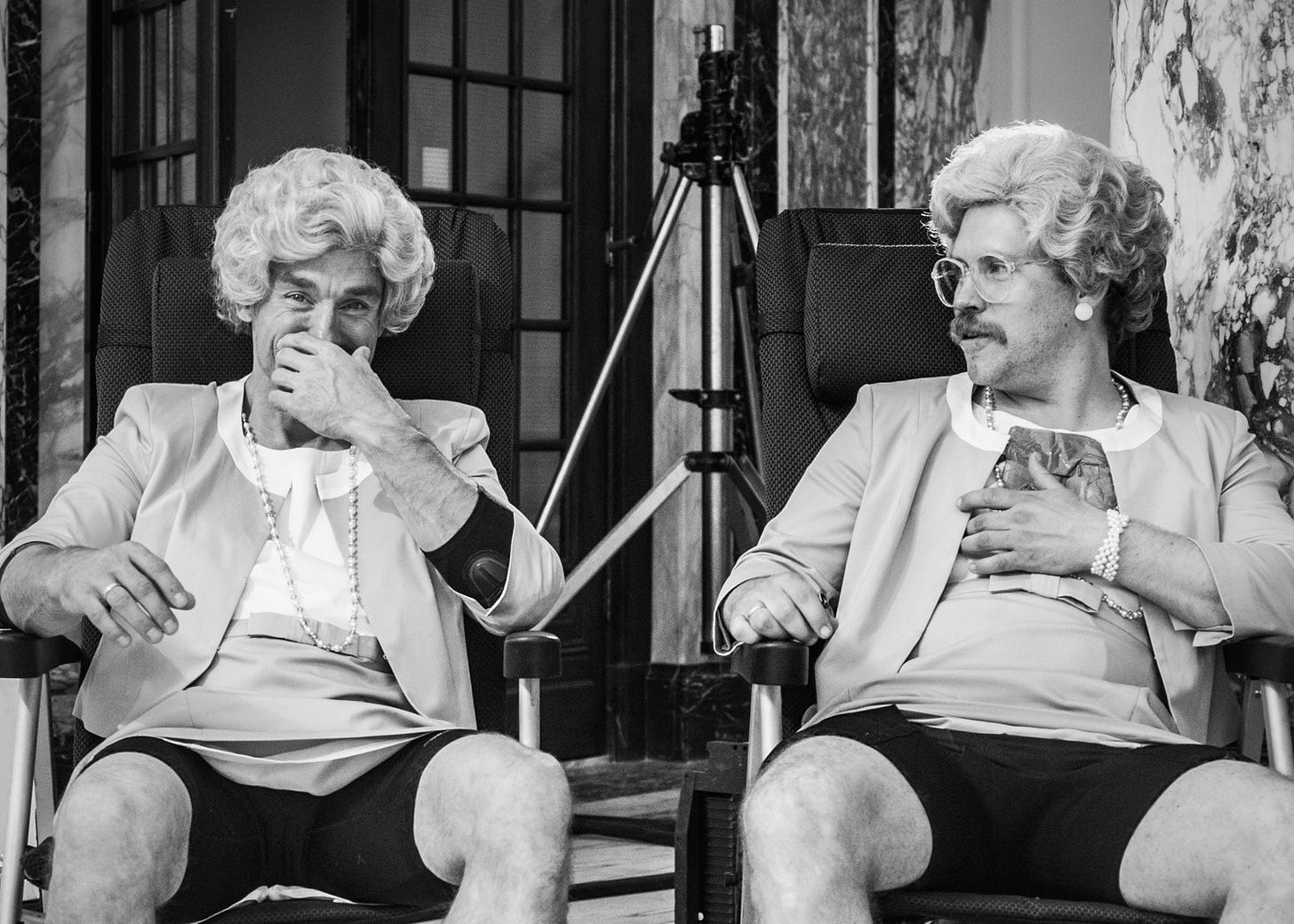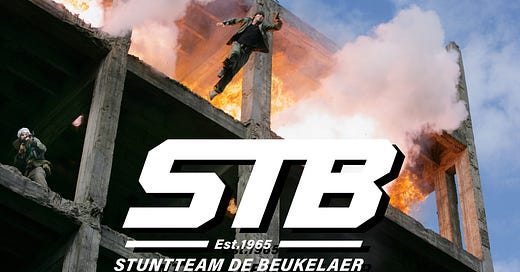Dare to Risk Less: Stunt Wisdom - STB Spotlight
In this article, we’ll explore what can be learned from the stunt industry’s approach to risking less—where success isn’t about fearlessness but about mastering the art of minimizing uncertainty 💥
When you think about stunts, it’s easy to picture thrilling action scenes that leave you on the edge of your seat. But, like the tip of the iceberg, the action we see on screen only consists of 10% or less of the actual stunt work. It’s all about preparation, precision and mindset—a formula that can bring safety and skill together.
Enter Stuntteam de Beukelaer (STB): founded in the late 1960s by Hammy de Beukelaer and now led by Marco Maas, STB has grown into the major stunt company across the Benelux region. With a wealth of experience, an international repertoire, and the best stunt crew from across Europe, they’re a force to be reckoned with.
Marco’s journey into stunts began almost by chance, but his strong foundation in sports and experience at the Ministry of Defense soon set him apart as an all-round stunt performer and coordinator. Over the years, he’s led STB to new heights, working alongside a devoted core team that handles everything from intricate rigging, high falls and diving to fire stunts and precision driving. Their project portfolio consists of big budget productions (The Hitman’s Bodyguard, Dunkirk) to smaller productions (New Kids Turbo).

Most people wouldn’t consider stunt work as the safest of professions, however I’d argue that people like Marco who analyse and decrease risks daily have an interesting point of view on taking risks. So when Marco and I had a chance to sit down we discussed decreasing risks in stunt work and how that translates to entrepreneurship. The following section details the 4 themes that came up during our conversation.
The Right People
STB has grown into an internationally recognized company, holding the largest market share in the Benelux region—a success driven by core values centered on performing amazing stunts safely and with the right team. But how do they identify the right people?
Marco shared that he receives several applications from stunt performers weekly, ranging from those just chasing a dream to those with actual experience. The first step is always an interview at the office to assess applicants' motivation, company fit, skills, and ambitions. For many, this is where the journey ends. Succeeding as a stunt professional requires a unique combination of hard work, resilience, and the ability to handle long, sometimes uncomfortable days on set that often come with their share of bruises. Only those who consistently show-up, maintain their skills, and proactively learn new techniques are invited to join STB’s select core team.
Being part of this core means exclusive work with STB as a self-employed contractor. This commitment pays off: core members gain invaluable training, learn company-specific methods, enjoy 24/7 access to the practice facility, and don’t have to worry about finding enough stunt work. Over time, they earn more responsibility as they demonstrate the right attitude to uphold STB’s high reputation and standards. This could include coordinating stunts or leading specific projects, depending on the person’s ambition and readiness.
Those unable to make the same time commitment can still participate occasionally if they fit a specific job profile. From the first interview, these expectations are discussed upfront, ensuring alignment with the company’s values. This transparency helps the company maintain a high standard and contributes to their growth.
Preparation
The focus on safety at STB originates from a deep belief in thorough preparation. This mindset was shaped by Marco’s personal experiences, including a challenging stunt for the movie Wilde Mossels (2000), where he was asked to jump from the Zeeland Bridge—an intimidating 19-meter drop that varies with the tide. With less safety protocols and a more laid-back approach of “just doing it,” Marco invested in extensive training with high divers himself, to ensure he was ready. Despite only being able to practice dives from 10 meters, Marco faced the challenge with a healthy dose of nerves. Strong currents, low tide, and restricted access for the rescue team added to the risk of the stunt. After one test jump to get the feeling, Marco completed the filmed take successfully on the first try.
Since taking over the company, Marco has made it clear: preparation is non-negotiable. This principle was particularly evident when newer stunt performers lacked car jump experience. To address this, Marco organized comprehensive training sessions with all necessary equipment provided and funded by the company, ensuring that all team members could execute these stunts safely on set. Obtaining certifications where possible is also strongly encouraged, reinforcing STB’s commitment to meticulous preparation and safety.
Analyses
Preparation is key in stunt work, but what happens on set is only the visible outcome of extensive behind-the-scenes groundwork. This process begins in the STB office, where a stunt coordinator conducts a detailed analysis of each aspect and team involved in executing the stunt. An analysis is compiled and communicated to clarify requirements and identify potential risks early on. Think of the following examples:
Consider the clothing stunt professionals have to wear. These rented garments often need special treatment, such as being fireproofed or tailored with cuts to attach wires to the harness underneath.
Or consider stunt driving scenes. On occasion, unprepared producers have used vehicles from extras or set personnel, leading to distress when those cars come back severely worn down.
Lastly, imagine a full-day water scene. If actors cannot wear wetsuits because of the choice of clothing, hypothermia can occur. The stunt team would have to schedule frequent breaks to prevent this, or the pool would have to be heated to a comfortable temperature.
All 3 examples show how easily misunderstandings can occur if teams underestimate the intense preparation that is required, and it always leads to extra costs and complications over who has to foot the bill afterwards.
Marco and his team prevent such scenarios by setting clear expectations upfront. They discuss essential safety standards and potential logistical issues with producers and directors to avoid unrealistic assumptions and unpleasant surprises. By addressing these requirements early on, they mitigate surprises and ensure smooth sailing on set.
Ambition
Even after thorough preparation, directors might still envision scenes differently, potentially downplaying key action sequences. This can stem from differing “artistic interpretations,” as Marco calls it, or a lack of understanding about the impact of the action itself. Take, for instance, a director who had planned an elaborate car collision—with fire and everything—for a film that was not focused on action. The director had opted to film the sequence from a distance, losing much of the impact, but that was the way he wanted to tell the story. Drawing from experience, Marco and his team placed a stationary camera close to the action just as a precaution (no harm in having extra material at no additional cost). As it turned out, this foresight paid off—the close-up shot was the one that was used in the end.
This blend of artistic insight, experience, and ambition has led Marco to take over the burden of a director by directing and editing the stunt scenes themselves. In this approach, STB assumes full control over the stunt scene, from initial planning to execution, filming, and editing. This strategy minimizes the risk of differing “artistic interpretations” and allows the team to excel at what they do best—preparing, performing, and capturing stunts backed by their extensive expertise.
These 4 themes come naturally to Marco and STB, but they can benefit any industry. Adopting a ‘stunt coordinator’ mindset helps reduce surprises and makes businesses more resilient to the challenges entrepreneurs often face.
Now, I'd love to hear from you. How could ‘Thinking like a stunt coordinator’ impact your own projects? Or…
Have you been in situations where foresight would have made all the difference?





